This September 11-15, at the National Championship Air Races in Reno, Nevada, a couple dozen magnificently restored airplanes will gather once again to be evaluated by judges and admired by fans. Those who attend will be able to stroll among some pretty special aircraft, hear the owners and restorers tell their stories, and watch the presentation of trophies by aviation heroes. (In 2003, Bob Hoover, above at left, handed out a few.) They’ll also get the chance to vote for their favorite airplanes.
By all means, get to Reno if you can. But if you can’t, we invite you to read the stories of these remarkable airplanes (below) and vote for the one that strikes a chord with you. Whichever one receives the most votes will win the People’s Choice trophy at Reno and be named “Air & Space Magazine Airplane of the Year.” The winner will also star in a future Air & Space feature.
The competition for the best restored airplanes is run by the National Aviation Heritage Invitational (NAHI), dedicated to the preservation of the country’s rich aviation history. Executive Director Ken Perich (above, center) and the NAHI volunteers have for the past 20 years brought together some of the finest restored classic and antique aircraft in North America.
Sept 16 update: And the winner is....Chris Galloway’s 1931 Waco QCF.
(Photo: NAHI)
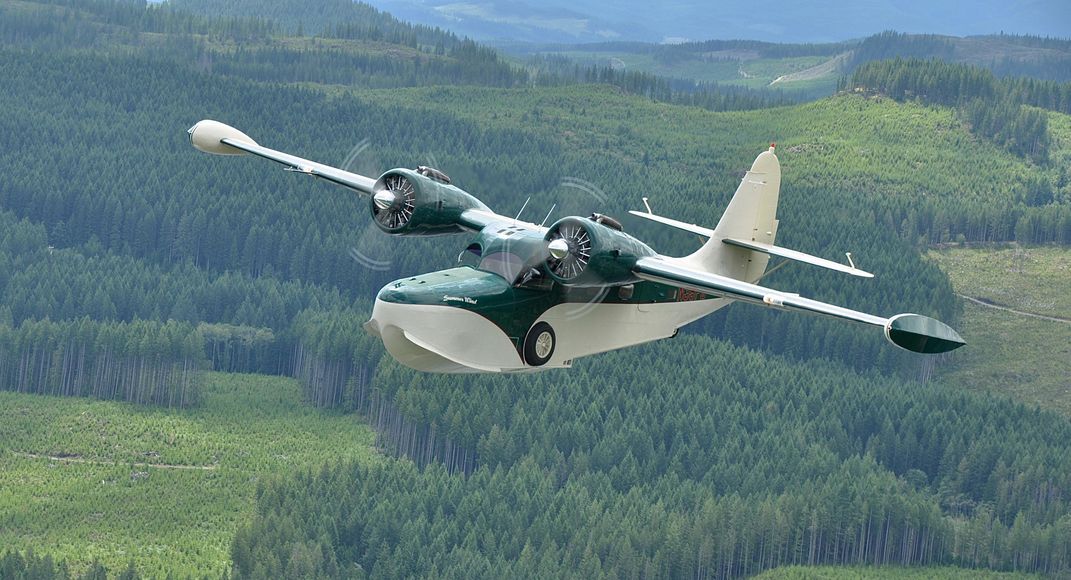
(#10) 1939 Grumman Goose
Survivor
The original customers for Grumman’s 1937 G-21 amphibian were wealthy Long Island businessmen looking for a comfortable commute to Manhattan. By the following year, military services began to buy, and the Royal Air Force, always expert at alliteration, christened it the Grumman Goose. It became a World War II phenomenon.The lovely green and white Goose in the NAHI contest is, according to its pilot Gord Jenkins, the oldest Goose still flying. Its first owner was Lehman Brothers financier Robert Lehman. He sold it to the Royal Canadian Air Force, which manhandled it—gear-up landings, engine failures—from 1942 into 1946.
Later Laurentian Air Services of Ottawa had it rebuilt after a Fleet 80 crashed into it. (The Fleet pilot was hand-propping and didn’t know the throttle was engaged. It flew off unpiloted, straight into the Goose.) Its next owner, Trans-Provincial Airlines, had it for about 20 years, during which it sank twice, in 1979 and 1992. Only after it was retrieved from Rose Harbour at the southern end of the Haida Gwaii archipelago did it come south to its current U.S. owner Gary Filizetti. Says Jenkins: “It’s just fascinating to me that it’s still going after all that rough treatment.”
See video of the 1939 Grumman Goose from LiveAirshowTV.
(Photo: Courtesy Bob Kobzey)
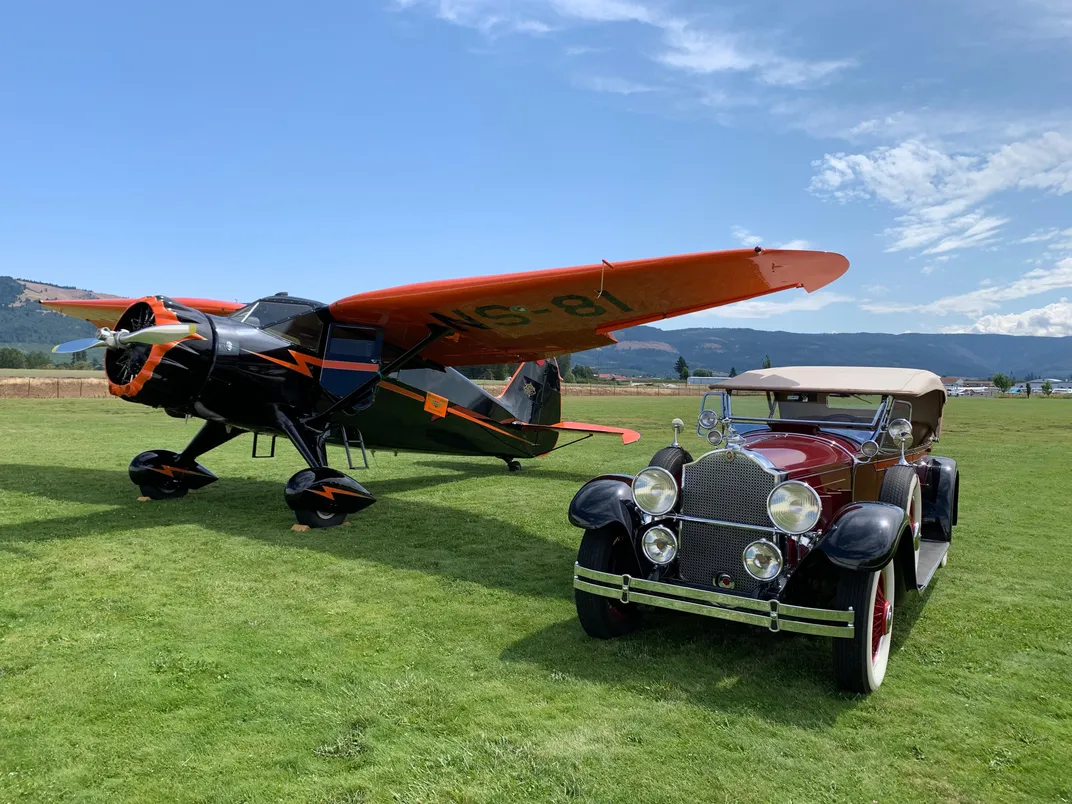
(#21) 1936 Stinson SR-8B
Soaring Bird
David Lunsford got his pilot’s license in 2011, but he remains, by his own description, “a new pilot.” His 1936 Stinson SR-8B—the one that just fetched him a Bronze Lindy Award in the Silver Age (1928-1936) Category at the AirVenture 2019 Aircraft Awards—was, for a man in the market for a vintage airplane, a practical choice. “I fly out of a high-altitude airport’—that would be Stevens Field in Pagosa Springs, Colorado, elevation 7,664 feet—”so I needed something that had a lot of lift and could fly slow,” he says. His Stinson, powered by a 300-hp Lycoming R680-13 that can take it up to 123 miles per hour in the air, fit the bill. “The unique thing about this Stinson is the gull wing, a kind of a compound curve wing. The span on it is elliptical instead of straight. It has flying characteristics like a soaring bird.”Lunsford’s airplane, N81E, was first owned by the Bureau of Air Commerce, a precursor to the FAA, which took delivery in January 1937, and used it to certify pilots on the type. N81E still has its blaze-orange wings with U.S. markings on them. “It’s very beautiful and very visible in the air,” Lunsford says proudly. Prior to its restoration, the airplane hadn’t flown since the 1980s. “Plus, it’s just elegant,” Lunsford adds. Too elegant to stay Earthbound.
See video of the 1936 Stinson from LiveAirshowTV.
(Photo: Wes Valpey)
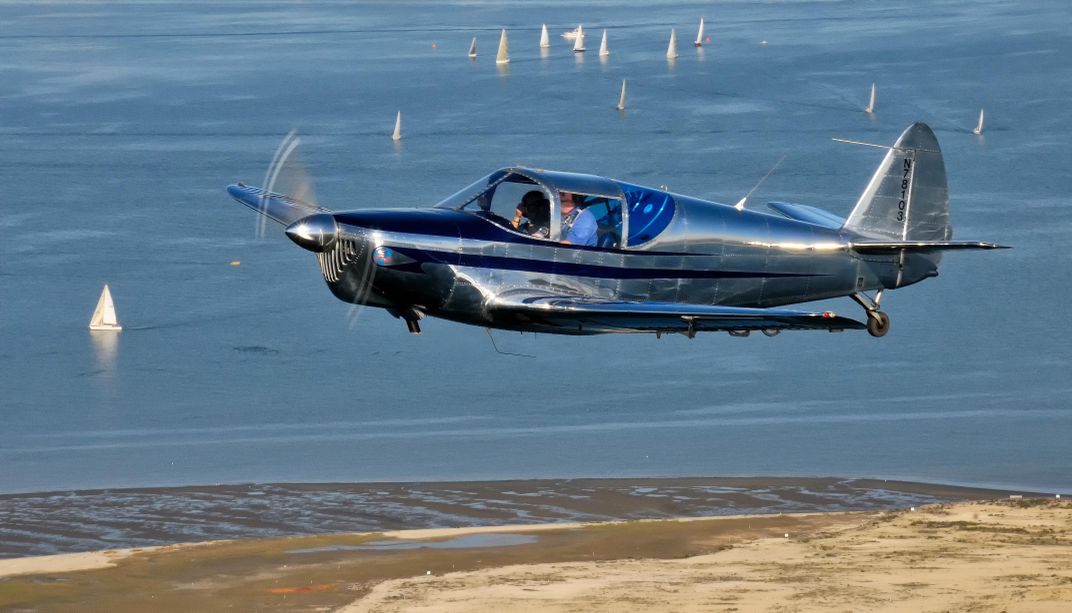
(#18) 1946 Globe Swift
Rope-Tugger
Jim “Frog” Jones, President of the Swift Museum Foundation in Athens, Tennessee, first clapped eyes on a Swift in 1973, not long after he’d begun his flight lessons in a Cessna 150. He asked his instructor what it was. 46 years later, Jones still remembers the reply. “He said, ‘That is one of the most beautiful airplanes that has ever been built. That is a Swift. It’s tugging at the ropes, saying ‘Come fly me.’” He bought his Swift in 1974, and he’s still flying it, having logged some 4,000 hours in the cockpit.Jones’s swift was built by the Texas Engineering and Manufacturing Company, or TEMCO, the outfit that original manufacturer Globe Aircraft contracted to help it produce the airplane, and which kept making it circa 1947-50 after Globe, having undervalued its own airplane, fell into bankruptcy. But the Swift that’ll be at NAHI, belonging to Karl and Donna Johanson, is a gorgeous, original Globe-built edition of the classic all-metal monoplane—albeit one that has its power plant upgraded. Some conversions carry as many as 200 horses in their Lycoming engines, Jones says, making them ideal for cross-country touring. Jones has made the 4.5-to-five-hour flight from Madison, Georgia to Oshkosh for AirVenture almost every year since 1983, he says. He loves taking his Swift on tour because of its “ramp appeal,” especially from younger homebuilt buffs who can hardly believe they’re looking at a post-WWII airplane.
“[RVs are] fun-flying airplanes,” Jones says. “They’re fast and very efficient. However, they all pretty much look alike. When a Swift is sitting on a ramp, people ask what kind of RV it is. And when you let them know it’s a Swift that was built in 1946, or ‘47 or ‘48, they’ll say, ‘No way.’ The Swift has a history, it has a heritage, and it has a soul. Because it’s an antique classic.”
See video of the 1946 Globe Swift from LiveAirshowTV.
(Photo: Eric Rosen, Desert Rat Photography)
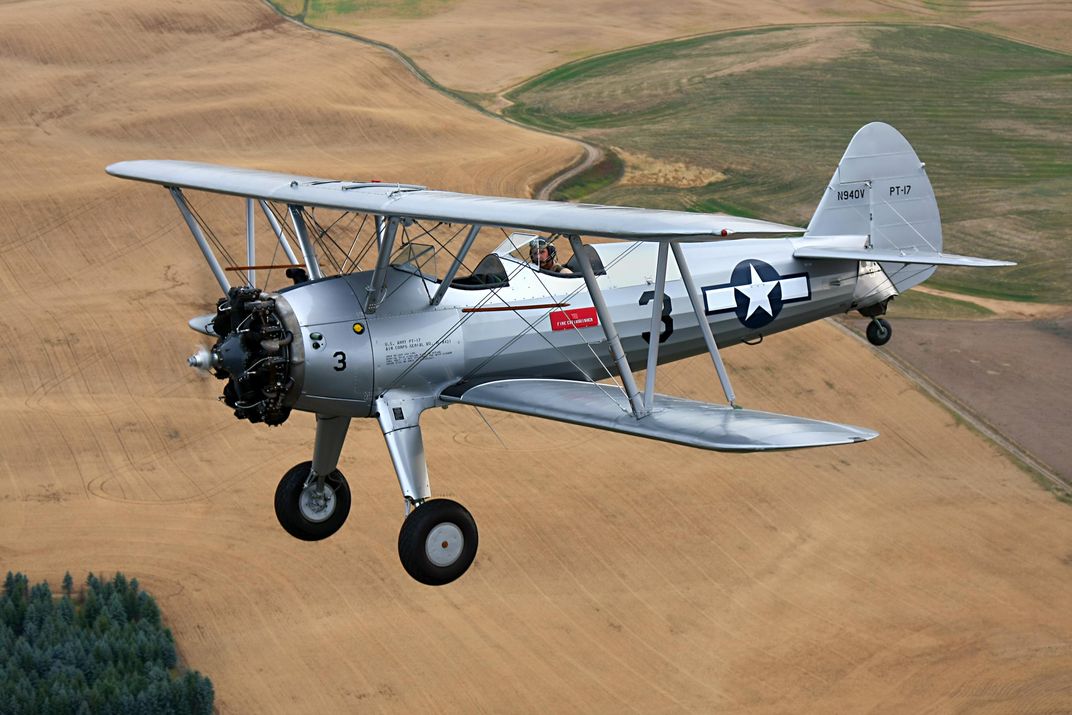
(#17) 1941 Stearman Kaydet
“Welcome to the Sky”
If you’ve ever been lucky enough to hop a ride in an open-cockpit biplane, chances are you flew in a Stearman, but not like this one. “This is the real deal,” says owner John Sessions. “It has never been a cropduster.” Among the many vintage aircraft types flying today, Stearmans are among the most plentiful. Both the U.S. Navy and Army Air Corps bought them as primary trainers, and they introduced more U.S. World War II pilots to flight than any other type. Boeing built 8,584 (plus 1,762 more in parts), and after the war, many hundreds were pressed into service as agplanes. By some estimates, more than 1,000 are still airworthy.But the Stearman that John Sessions flies is unique. It had a single owner from 1946, when it was bought as war surplus by William Lehman Clark, until 2005, when Clark died, at 104. Renowned Stearman restorer Larry Tobin acquired it from Clark’s daughter, and Sessions, who established the Historic Flight Foundation—with a collection based at Paine Field in Seattle and next month at a second location, Felts Field in Spokane—bought the project as soon as he heard about it. Airplanes that move through multiple restorations by various owners sometimes end up with creative repairs undreamed of by the original manufacturer. Not this Stearman. Sessions says: “Where the wood rib attaches to the fabric side panel—if Stearman built it with a leather transition, then this one has a leather transition. As it was coming together, we attracted people from great distances to see how they really did it back in the day.”
Although Lloyd Stearman had become president of Lockheed by the time Boeing, with whom he’d been affiliated, got the trainer contract, the name Stearman clung to the sturdy trainer that descended from his line of biplanes. Nobody calls it a Kaydet, but plenty of young men about to head off to war called it “forgiving” and honored it for giving them the chance to recover from stupid novice mistakes. One of those young men was a Navy flight student named George Herbert Walker Bush, who said in 1994, “If someone said, ‘Your life depends on it: You must this minute solo in [an airplane], I would instantly choose the Stearman. It would forgive me my trespasses.”
See video of the 1941 Stearman from LiveAirshowTV.
(Photo: Ryan Pemberton)

(#16) 1944 Beechcraft D17S Staggerwing
Bull in a Mink Coat
Almost as soon as he established Historic Flight Foundation, in Seattle in 2003, John Sessions and his board of advisers knew that a Beechcraft Model 17 Staggerwing should be in the collection, which traces the technological advance between two historic Atlantic crossings: Lindbergh’s in 1927 and the Boeing 707’s first in 1958. Within that time period, Walter Beech created some of the most advanced aircraft of the 1930s, and the Staggerwing is perhaps the loveliest physical expression of his genius.Sessions calls it “a bull in a mink coat.” He says, “Most pilots consider it to be in the top three of the most beautiful airplanes ever produced. And it was also an early user of the Pratt & Whitney 985 radial engine, so you have 450 horsepower in a relatively light airplane. The person who might buy a Staggerwing in the thirties would be a candidate 20-plus years later for one of the early Learjets.” The airplane came to represent speed, elegance, and the leading edge of technology.
Sessions had his heart set on this particular Staggerwing because it’s first flight from the Beech facility in Wichita in 1944 was to Sand Point Naval Air Station—“right in our back yard in Seattle,” he says. It became a Navy reconnaissance airplane during World War II, conducting shore patrols and transporting Navy brass. Post-war, its career was typical for a Staggerwing: owned and loved by wealthy businesspeople who wanted to impress customers and get executives from one meeting to the next. The problem was that the airplane belonged to the Beechcraft Heritage Museum, and the museum loved it too. Sessions was patient, checking back in from time to time. Years passed. The Beechcraft museum was bequeathed two other Staggerwings, and members started hankering for a new hangar, so Sessions got a call: “John, you know that Staggerwing you wanted to buy?”
The airplane won the 2017 NAHI trophy for best restoration in the Classic division.
See video of the 1944 Beechcraft from LiveAirshowTV.
(Photo: Terry Green)
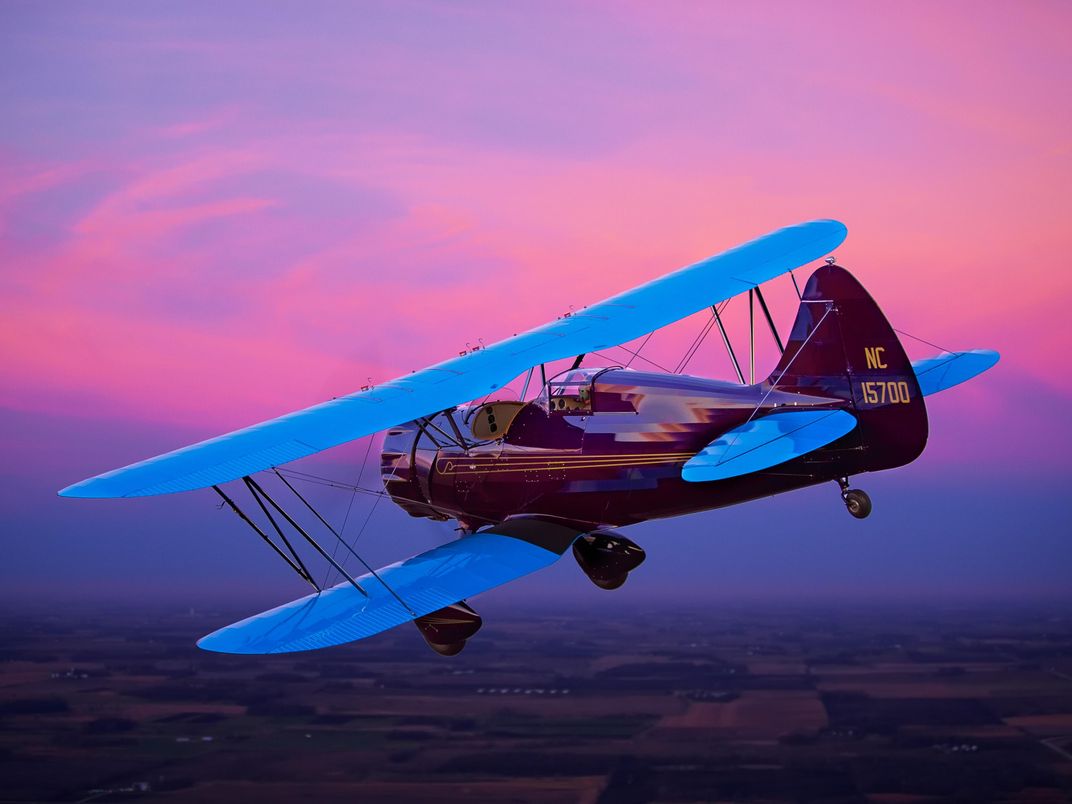
(#20) 1935 Waco YPF
Watch Your Six
The coupe-top YPF that 24-year-old Constance Eugenie Johnson, a somewhat mysterious woman of means, ordered in 1935 was one of only two F-models built that year. They were the latest, most luxurious offerings, featuring the improved Clark Y airfoil, the bump cowl, the redesigned empennage, and that sliding coupe-top, that would have the “6” appended to their designation the following year. Twenty-two feet, 10 inches long, eight feet, five inches tall, and sporting a 30-foot wingspan, these 225-horsepower Jacobs-powered biplanes cut dashing figures.But NC15700 was more arresting than its sibling: “Connie” Johnson had specified an eye-catching paint scheme of metallic purple for the fuselage, royal blue for the wings, and a subtle inlay of her initials in gold. She also specified that the Waco logo was not to appear on the airplane at all. She owned the airplane less than a year before selling it—an April 1936 engine fire apparently gave her cold feet about taking it up again—but it still retains the memorable color scheme Johnson indicated.
Today, NC15700 is the last YPF still flying, and it has had a colorful history: Before World War II, Chuck Doyle Sr. used to do parachute jumps from it while then-owner Bill Shaw flew. Doyle couldn’t fit in the cockpit wearing his ‘chute, so he had to stand on the wing while Shaw ascended to jump altitude. Decades later, the airplane spent a long time on its back after another owner, Wyoming rancher Spencer Harper, tried to use it as a snowblower to clear a wintry pile that had accumulated in front of his hangar. The Waco nosed over and didn’t fly again for decades.
Its most recent owner, Jerry Wenger, bought it in 1999 and hired Ben and Jeremy Redman of Rare Aircraft to restore it, upgrading its engine and propeller to a 275-hp Jacobs R75-B2 and a constant-speed Hamilton Standard, respectively. Wenger donated the YPF to the Western Antique Airplane and Automobile Museum in Hood River, Oregon. Wes Valpey, a full-time vintage airplane flight instructor with about 700 hours in various Wacos as well as a volunteer with the museum, says the Waco has “the most comfortable, with the best harmonized controls of the Golden Age airplanes that I’ve flown.”
See video of the 1935 Waco from LiveAirshowTV.
(Photo: Mike Fizer)
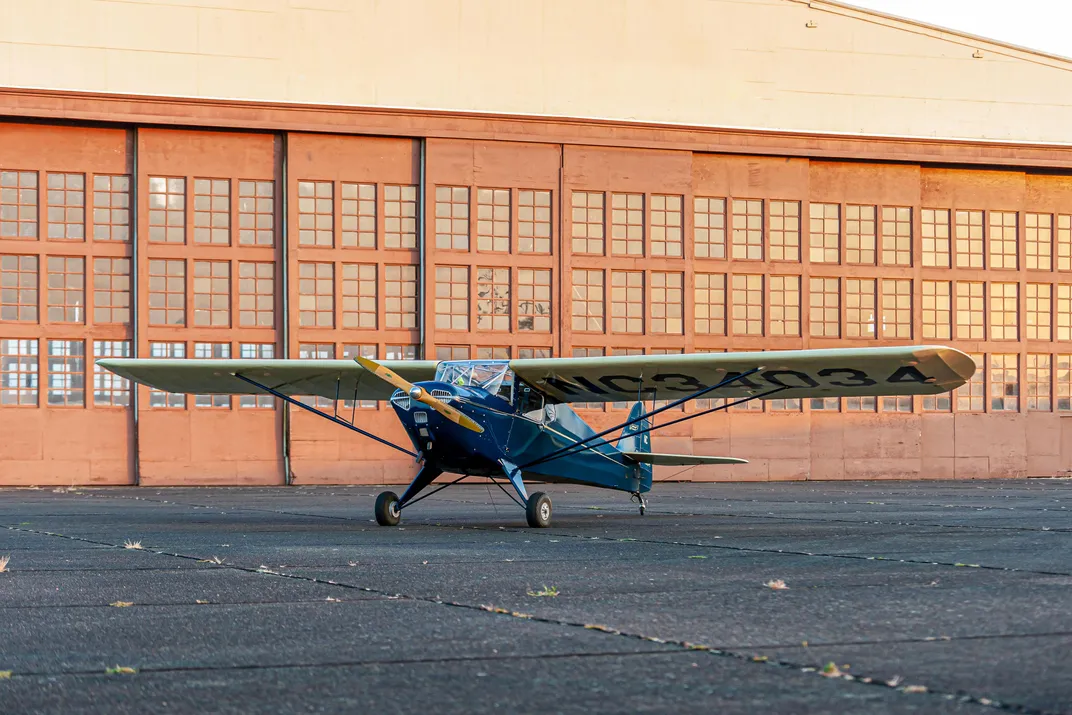
(#26) 1941 Taylorcraft BC-12-65
The Original
After seeing Cal Rodgers fly the Wright EX Vin Fiz over New York in 1911, the teenaged C.G. Taylor was so inspired that he built an aircraft of his own design in his parent’s attic. (The sections were lowered through the attic window into the yard below for assembly.) By 1928 C.G. had formed an aircraft company with his brother Gordon, in Bradford, Pennsylvania, with William T. Piper as an original investor. When the Great Depression forced C.G. to liquidate the company, Piper bought him out, retaining C.G. as company president and chief engineer. (The ubiquitous Piper Cub was based upon one of Taylor’s designs, modified by another designer while Taylor was out sick. William Piper liked the revised design so much, he bought out Taylor’s share in the company. A gentle rivalry exists to this day between Taylorcraft and Piper Cub owners.)One of C.G.’s designs, the Taylorcraft B, would eventually be produced in 27 variants. One of those, a 1941 Taylorcraft BC-12-65, was sitting on the ramp at the Corvallis Municipal Airport in 1992 when Mark Baxter first saw it. He had no idea the ratty old tail-dragger would change his life. “I can’t even explain it,” he says. “I saw this thing sitting on the ramp and fell in love with it.” Baxter would take all of his flight instruction, solo, and complete his check ride in the T-craft. When the aircraft came up for sale a year later, Baxter and his kid brother Eric bought it (kind of like C.G. and Gordon), flying until it was held together with little more than safety wire and duct tape. They embarked on a restoration in 2000 under the guidance of Tim Talen; nine years later they finished. While Baxter didn’t know anything about restoration when he began (“I couldn’t tell the difference between a longeron and a wing rib,” he says), the restoration led to a second career: For the past 15 years, Baxter has run a small business tuck-splicing control cables on antique aircraft. He also became a board member of the Oregon Aviation Historical Society. The brothers don’t know too much of the history of their aircraft, other than it was part of a batch of 10 Taylorcraft flown in 1941 to Hubert & Dillon Air Service, a dealership in Tacoma, Washington. The airplane was owned by the Defense Plant Corporation during the war, and likely trained new cadets; other records were lost in a fire in the 1970s.
“Flying the plane is a great joy,” says Baxter, “but what is most important to me is that the Taylorcraft has brought me so many experiences in my life that I never would have had.”
See video of the 1941 Taylorcraft from LiveAirshowTV.
(Photo: Mark and Eric Baxter)

(#25) 1967 Cessna O-2A Skymaster
Aerial Director
The venerable “Oscar Deuce” was born from Cessna’s Model 337 Super Skymaster, an unusual civilian utility aircraft powered by a pair of Continental engines, one pushing and one pulling. With a revised cabin, a new suite of military electronics, and additional weapons-carrying capacity, the first U.S. Air Force O-2A Skymasters went into service in Vietnam in March of 1967, just three months after the initial flight of the prototype.Used as Forward Air Controller (FAC) aircraft, low-flying Skymaster crews coordinated attacks and helped orchestrate rescues, marking targets with white phosphorus rockets, communicating with nearby ground units, and directing a multitude of helicopters, attack planes, and fast-moving jet aircraft. While the Skymaster’s twin tail booms gave it a distinctive appearance, the O-2s spent much of their time operating in the dangerous space between the attackers and the enemy. Some O-2 flyers painted unofficial messages in large block letters on the tops of their wings such as, “The FAC” and “Don’t Shoot” in an attempt to avoid becoming targets themselves.
The airplanes continued to serve in U.S. military units into the early 2000s with the last being retired in 2010. The Cactus Air Force Wings and Wheels Museum retrieved four retired O-2A from storage at Davis-Monthan Air Force Base in 1996. “The airframe we chose for restoration had a known combat history,” says staffer Stephen Mays. It was assigned to the 23rd Tactical Air Support Squadron (TASS) in Thailand from 1967 to 1971, and then to the 19th TASS in South Vietnam. After the war, the plane served in the Michigan Air National Guard until its retirement from the Air Force in 1980.
See video of the 1967 O-2 Skymaster from LiveAirshowTV.
(Photo: Courtesy Cactus Air Force)

(#11) 1968 Cessna M337B Super Skymaster
Back on Duty
Slowly but steadily the Cessna O-2A Skymaster island-hopped across the Pacific Ocean. It was October 1969, and the aircraft was traveling from Hamilton Air Force Base in northern California, toward Binh Thuy, Vietnam, where it would become a Forward Air Controller aircraft with the 504th Tactical Air Support group. It would serve with the U.S. Air Force from 1969 to 1975, until it rotated back to Davis-Monthan Air Force Base. There it sat until the early 1990s, when it was converted to a civilian configuration, the Super Skymaster 337B.In 2004, the aircraft—still sporting bullet holes, underwing hardpoints, antennas and belly skids—was purchased by Bob Miller, its third owner. “Both the engines and the props had been rebuilt,” says Miller, “and all the military avionics taken out.”
The O-2, meant to compliment and eventually replace the O-1 Bird Dog, was sent to the most hazardous combat zones in Vietnam. Their low-level mission made them vulnerable to ground fire, and Miller’s aircraft is no exception, sporting about 15 bullet holes. “Sylvester—so-called because of the tuxedo cat riding two rockets painted on the nose—allegedly belly-landed eight times in Vietnam,” says Miller. “The Air Force got to the point where they put two long skids under the belly so that if you stopped the front engine so that the prop was horizontal, you could fly it right onto the ground with the rear engine running. All they had to do was jack it up, repair a couple of antennas, and put it back in the air.”
While Miller hasn’t tried a belly-landing, he has had the front engine quit, which he describes as a “non-event.” “The plane is very docile with one engine,” he says, “and it’s just like flying a heavy [Cessna] 182.”
In a nice twist of fate, the aircraft will return part-time to military service: Miller is training in the Coast Guard auxiliary as a search-and-rescue pilot.
See video of the 1968 Cessna M337B from LiveAirshowTV.
(Photo: Courtesy Bob Miller)
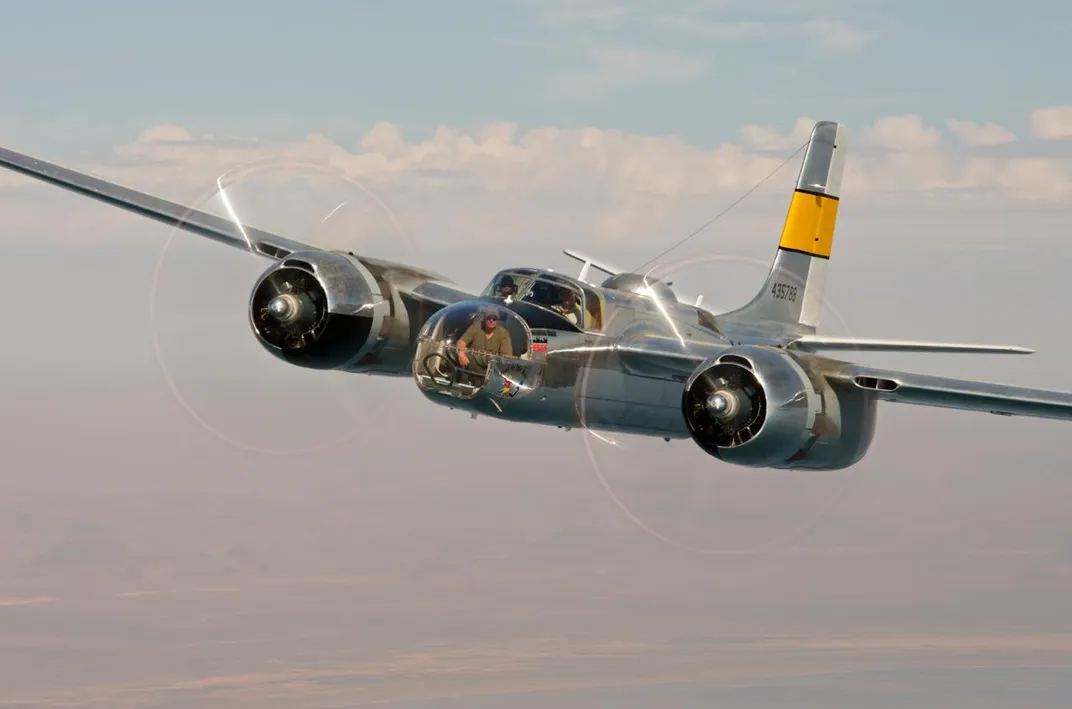
(#23) 1944 Douglas A-26C Invader
Mystery Machine
The A-26 Invader attack aircraft is speedy, tough, and versatile, but it is perhaps best known for its longevity. Built during World War II, some of the light bombers continued to serve the United States Air Force in combat throughout Korea and into Vietnam. Other examples were sold into the civilian market and heavily modified to become high-speed executive transports in the 1950s.The Cactus Air Force Wings and Wheels Museum’s A-26C was built in 1944 in Tulsa, Oklahoma. The bomber flew with both the Army and then the Air Force before it was sold to a Miami-based company that specialized in converting warplanes into business aircraft. After passing through the hands of many private owners, the aircraft became a museum piece, in the collection of the EAA Aviation Museum in Oshkosh, Wisconsin.
During an extensive restoration in the early 2000s, workers were startled to find several bullet holes in the tail of the aircraft. Since the airplane had no known combat history, the puzzling discovery led them to believe that the Invader might have been employed by the CIA during the failed Bay of Pigs Invasion in April of 1961. No one has been able to locate any documented proof that the Invader was involved in the famous failed operation to overthrow Cuba’s Prime Minister, Fidel Castro—but maybe its murky past was made murky by design.
Today the venerated Invader appears at airshows throughout the American West, including the National Championship Air Races. The airplane won the Howard Hughes Trophy in the large aircraft category from the National Aviation Heritage Invitational in Reno in 2014.
See video of the 1944 A-26 Invader from LiveAirshowTV.
(Photo: Courtesy Cactus Air Force)
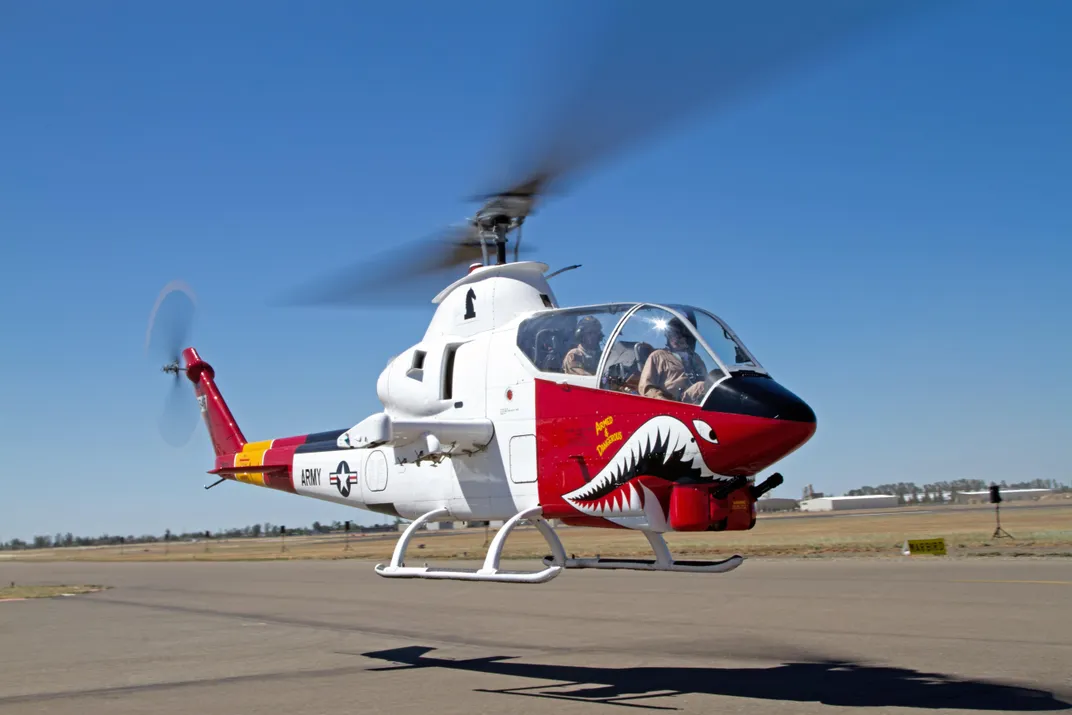
(#22) 1970 Bell AH-1S Cobra
Stunning Snake
The Cobra was born from the ubiquitous Bell UH-1 “Huey” helicopter of the Vietnam War era. It used the same engine, transmission, and rotor system as the famous Huey, but the AH-1 Cobra is a specially built, attack helicopter designed with a narrow fuselage, tandem seating, and ample room for weaponry. Pilots unofficially called the new machine the “Huey Cobra” and the “Snake.”In Vietnam, Cobras often worked in concert with OH-6 Kiowa scout helicopters in “hunter-killer” teams, with the smaller OH-6s trolling for ground fire and the heavily-armed Cobras swooping to attack exposed targets. Cobras arrived in time for the Tet Offensive in 1968 and served with U.S. Army units until the end of hostilities and beyond. Improved versions of the helicopter continue to serve with Marine Corps units today.
The Cactus Air Force Wings and Wheels Museum’s Cobra was built as an Army AH-1S attack and trainer helicopter in 1970. The aircraft was flown at stateside Army bases until its retirement. The museum purchased the helicopter as a derelict hulk in 2004. “I came into the hangar one morning and there it was,” recalls staffer Stephen Mays. “There were parts and pieces of that green helicopter all over the floor.” After locating a new tail section and many additional parts for the project, the museum’s staff restored the machine back to flying condition. The helicopter, today named Armed & Dangerous, appears in the high-visibility colors used by the U.S. Army’s 120th Aviation Company, the “Arctic Knights,” in Alaska in the late 1960s and early 1970s.
See video of the 1970 Cobra from LiveAirshowTV.
(Photo: Courtesy Cactus Air Force/ Carson Airport)
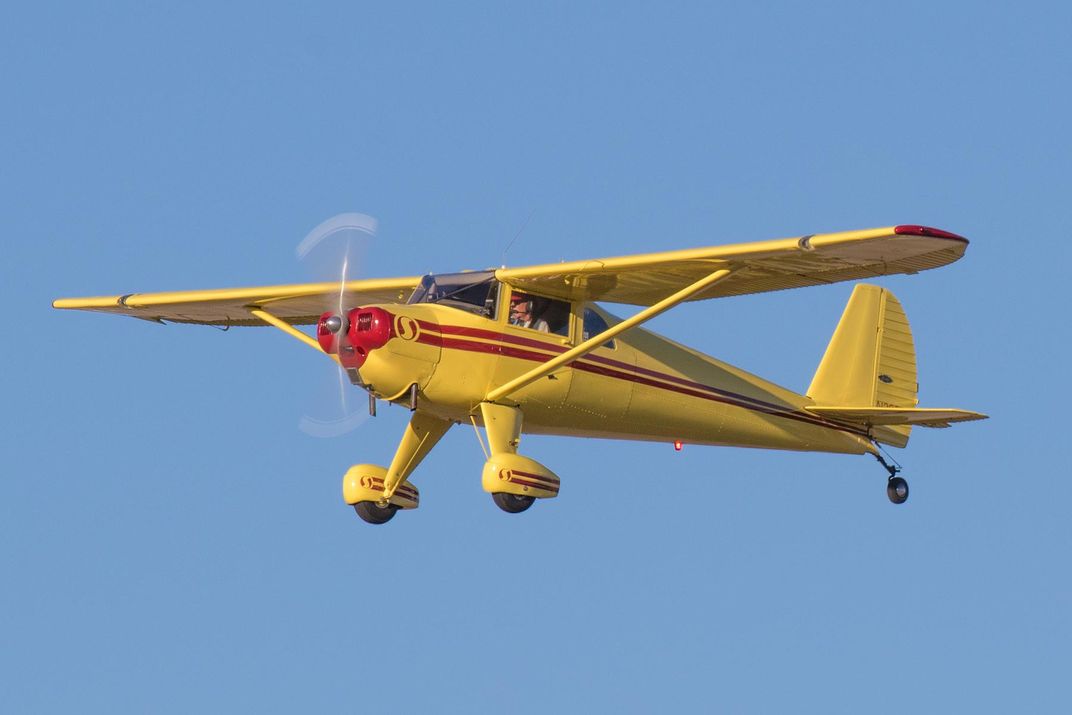
(#19) 1947 Luscombe 8E Silvaire
Criminally Underappreciated
The Luscombe’s Model 8 advertising had the tagline, “No Wood, No Nails, No Glue.” In the late 1930s, it was revolutionary for such a small and inexpensive aircraft to come from the factory without wooden spars, wing ribs, and other components. The simplified yet strong all-metal construction allowed Luscombes to be built fast and offered at competitive prices. The Model 8’s light airframe made the airplane 10 to 20 mph faster than its competitors.After the interruption of World War II, Luscombe offered improved Model 8 designs, including Rob Flannery’s 8E Silvaire, equipped with a Continental C-85 engine. The airplane, which Flannery calls Snoopy, was his first Luscombe—he currently owns six of them. “They are small. You can’t have just one,” he deadpans. “More than anything, they all just kind of found me.” Flannery notes that Luscombes are almost criminally underappreciated. “I almost hate to let the secret out, but they are delightful to fly,” he says. “They can turn on a dime, are nearly stall-proof, and incredibly cute too.”
For decades, there has been a persistent rumor that Luscombes have a tendency to ground-loop. “They do have a big rudder,” Flannery explains, “but it’s the skill level of the pilot, more than anything, that is the real issue. Being heavy on the rudder pedals during landing can bring trouble,” he notes, “but it’s all that wonderful surface area that can get a flyer out of a hairy situation too.” Flannery should know, he’s used that rudder in some wicked cross-winds while flying in his home state of Colorado.
“I’ve had this plane at 18,000 feet while crossing local mountain ranges,” he explains. “Luscombes are incredibly efficient. I sometimes take the plane into isolated back-country airstrips. Without fail,” he says, “other pilots always walk up and ask, ‘How in the world did you get that, into here?’ ”
See video of the 1947 Luscombe from LiveAirshowTV.
(Photo: Roger Cain)
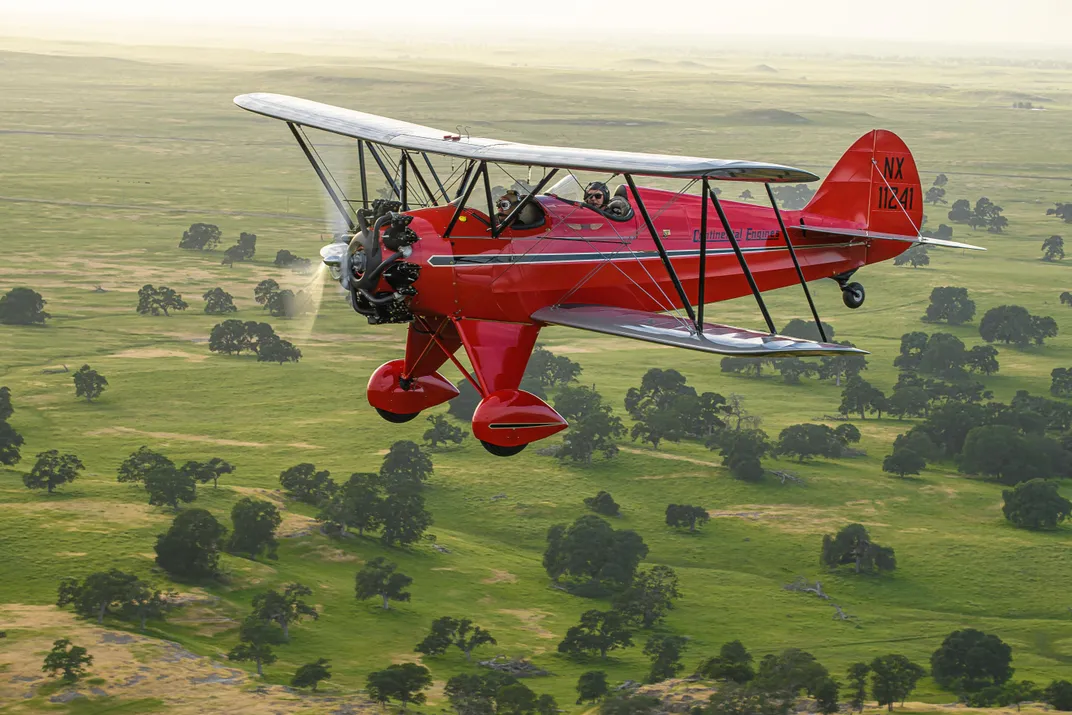
(#4) 1931 Waco QCF
Early Success Story
Chris Galloway always liked the look of a Waco F series. His first flight in his 1931 Waco QCF was only about a year ago—August 24, 2018. He remembers the date because it was a long time coming: Three-and-a-half years after he bought the open-cockpit biplane, during which time he awaited a necessary soup-to-nuts restoration. “The airframe is still original,” Galloway says. “As original as an almost-90-year-old airplane can be.”But stars can make people wait, and Galloway’s F series was a star before its owner had flown his first Piper Aero. It had won a prior owner, M.H. “Curly” Havelaar, the Oshkosh Reserve Grand Champion Trophy in 1979 (the year Havelaar completed his lengthy restoration of the airplane) and again in 1987.
Waco did not make a habit of selling its prototypes, but it sold this one—whose test pilots gave it the endearment “Betsy”—to Continental Engines in 1931, where it became the test bed for what became the Continental R-670, the engine that powered thousands of Stearman Model 75s. Havelaar managed to locate and correspond with former Continental test pilot Paul E. Wilcox, who said he enjoyed flying it, a refrain on WACO’s 1930s marketing slogan, “Ask any pilot.”
Betsy remains a conversation starter at fly-ins today. “I’ve never seen anybody walk up to it who doesn’t want to touch it or take a picture or both,” Galloway says. “It flies as well as it looks, and you can’t say that about every airplane, that’s for sure.”
He’s reluctant to say what he’s put into restoring the airplane, but when it came to justifying its initial price Galloway found some unexpected help. Most Wacos have data plates indicating only their month and year of manufacture, but Betsy’s gives an exact date: April 4. This detail had escaped its new owner’s notice until he brought his wife—whom he had not consulted in advance of the purchase—to the airport to show her his latest restoration project. Thinking quickly, Galloway said, “Look, Honey! She shares your birthday.”
See video of the 1931 Waco from LiveAirshowTV.
(Photo: Courtesy Moose Peterson)
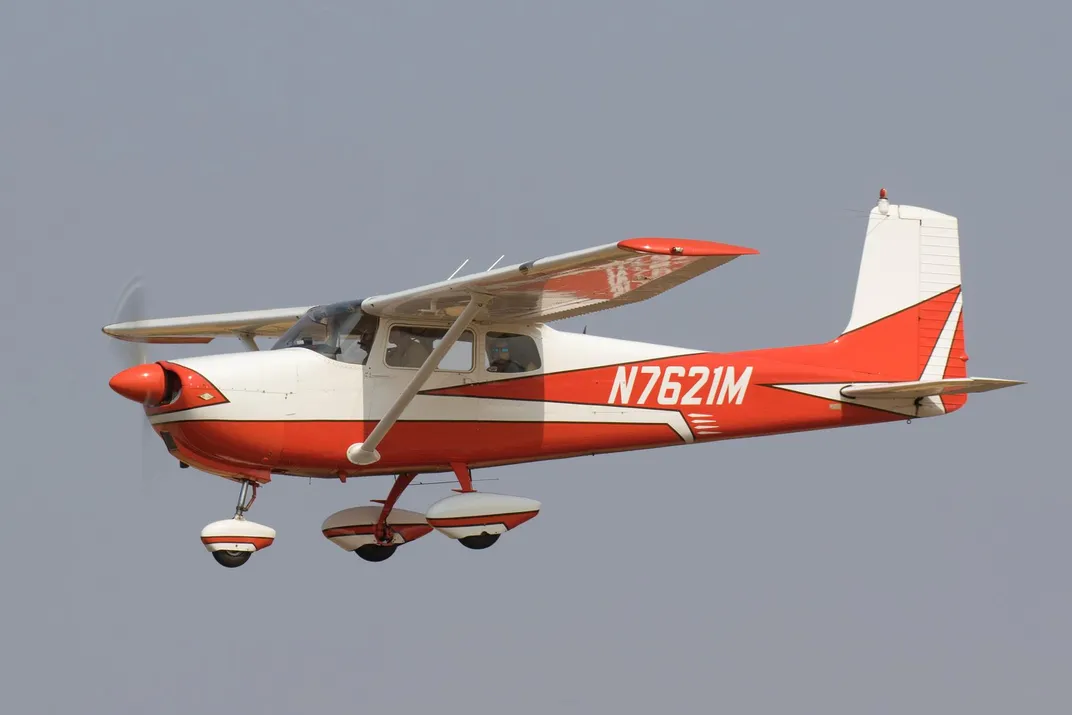
(#15) 1959 Cessna 175 Skylark
One of the Family
The airplane’s name is Lucy. Not too many aircraft become family members, but owner Richard Torres says that Lucy is part of his. “She’d probably be at home in the great room next to us,” he says, if they could get her in there. The Skylark is named after red-headed television star Lucille Ball; it sports its original Skylark Deluxe paint scheme, complete with those stunning red highlights. Lucy joined the Torres family when Richard, his son, and his girlfriend all three found themselves renting airplanes to pursue their costly love of flying. They had seen the vintage Cessna around, somewhat neglected, but never thought they’d get the chance to own it. “She was simply a hangar queen,” says Torres. “The plane was lonely.”
Then something amazing happened. “I’m up at the airport and walking through the office and I see the plane of our dreams in a sales flyer on the community board,” says Torres. “When nobody was looking, I ripped the ad off the wall,” he laughs.
The peppy four-seater cruises happily at 130 mph, and it just suits the Torres family. “In the past, the plane flew maybe eight hours a year,” he explained. “We have put more than 150 hours on the airframe in the last 11 months.” Lucy is loved. “We love just staring at this plane,” says Torres. “I cannot believe it’s ours.”
See video of the 1959 Cessna from LiveAirshowTV.
(Photo: Roger Cain)
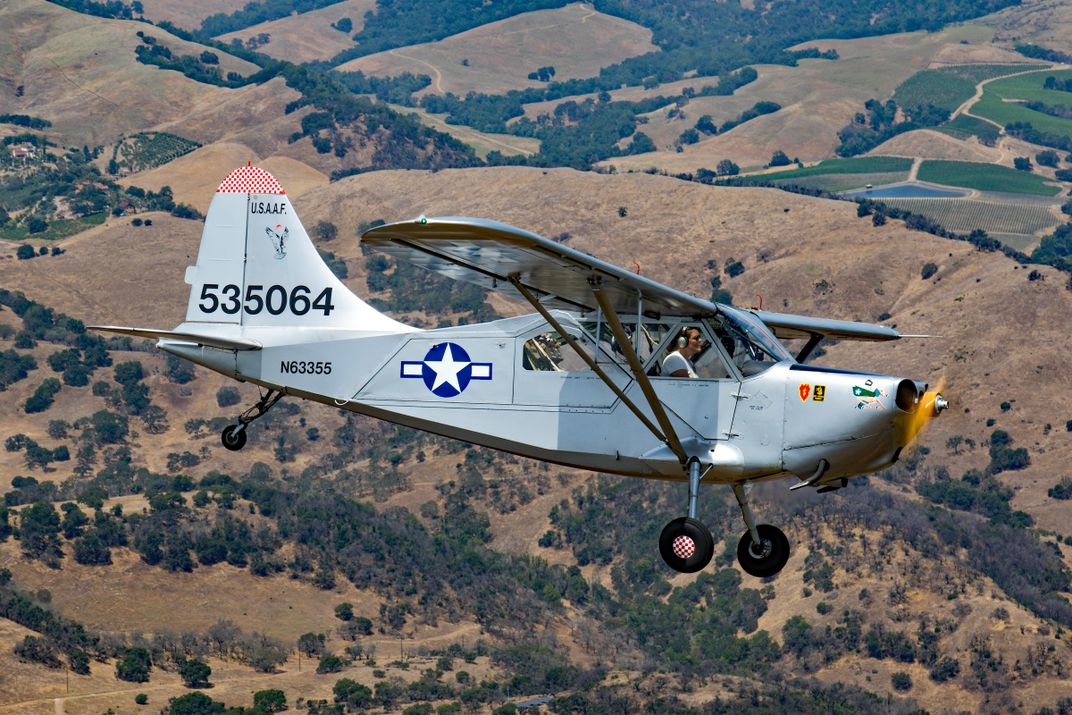
(#12) 1945 Vultee Stinson L-5G Sentinel
Connections
It’s such a cute little airplane that it’s hard to believe it was one of the most important combat aircraft of World War II. The Stinson Sentinel’s durability sent it on a wide variety of missions—reconnaissance, resupply, rescue, VIP transport, courier, and artillery spotting. Called “the Flying Jeep,” the L-5 could take off and land almost anywhere, including on platforms constructed in the trees of thick Burmese jungle. Its job was making connections between bases and ships and soldiers in the field.Jan Johnson is the tenth in a long line of stewards for this unique Stinson ambulance. “It is my belief that we are never ‘owners’ of these rare antique aircraft,” she says. “We do all we can to keep them flying and in their best condition for the future—and for their next caretaker.” Johnson feels that role keenly because of how she came to own the L-5. Newly licensed at age 51, Johnson began flying her vintage Cessna to aviation gatherings across California, and she instantly knew she had found her clan. Among her new friends were Frank Huffman and the Stinson L-5 he had lovingly restored. Huffman loved to show off his airplane, which he’d rescued from the Nevada desert in 1987. He dreamed of one day showing it at EAA AirVenture, but he never got the chance. He died just months after telling Johnson about his dream. Johnson was shocked when she learned that Huffman had chosen her to become the L-5’s next caretaker.
Recently, Johnson became determined to make Huffman’s unfulfilled aspiration into a reality. She piloted the little L-5 from California to Wisconsin for AirVenture 2018. The 4,800-mile trip took 45 hours of flying time. At fly-ins, Johnson works to get as many kids into the cockpit as possible in hopes of sparking a love of aviation, and Oshkosh was the perfect place to inspire young flyers. She reflects, “I think Frank would have been proud.”
See video of the 1945 Stinson from LiveAirshowTV.
(Photo: Roger Cain)
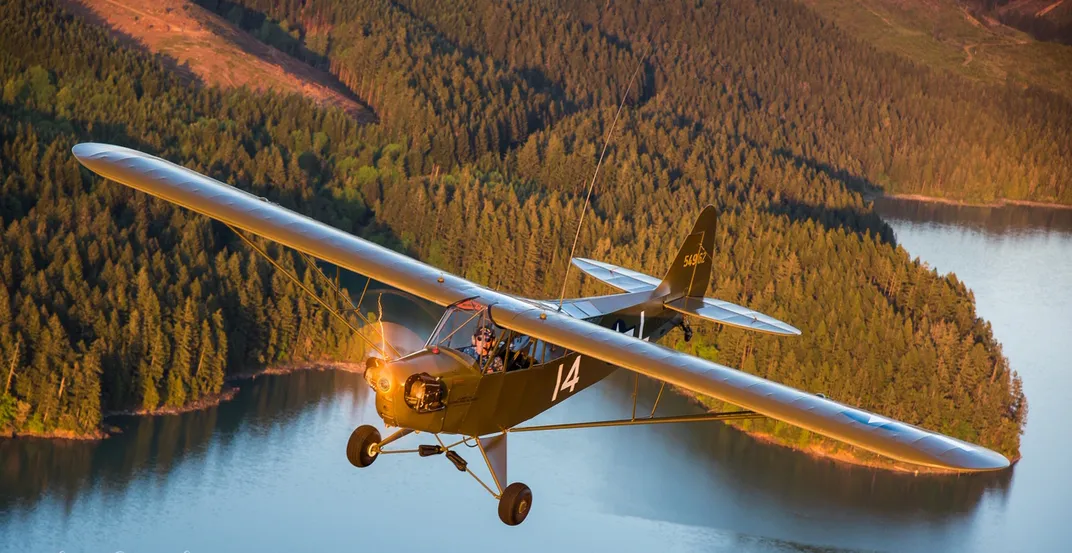
(#14) 1945 Piper L-4J “Grasshopper”
The Littlest Combat Airplane
When Ken Schmitt purchased a bare fuselage, skeletal wings, and a few airplane parts in 2000, he thought he was getting what was left of an old Piper J-3 Cub. “It was a basket case,” he says and then corrects himself, “It was barely a basket case.” But Schmitt wasn’t intimidated; he’d done this before, reviving a vintage wartime Stearman trainer in his spare time. As he dove into his new project, he was astonished to learn that his “civilian J-3” was actually a military model, an Army L-4J “Grasshopper.” “I was excited to rebuild another warbird,” says Schmitt.
Piper L-4s were used by the Army in every theater of war, spotting for ground units and ships, transporting men and supplies, and nearly always operating close to the front lines. Even on D-Day, Grasshoppers were in the sky, reporting to the Navy how to adjust the fire of the ships’ big guns. Schmitt’s airplane came out of the Piper factory in June 1945 and was sent straight to the Pacific. The Grasshopper flew from a base in the Ryukyu Islands, most likely Okinawa, and was later transferred to Leyte Island in the Philippines.
Schmitt took five or six years to get the airplane back in the air. “I could have done it quicker,” he explains, “but I’m meticulous and I always enjoy the work.” Now he takes the aircraft to as many shows as he can. He says, “I’m a veteran myself and the plane gives me a chance to meet people and hear about their experiences. The plane is an important part of our history.”
See video of the 1945 Piper L-4J from LiveAirshowTV.
(Photo: ©LCLPhotography )
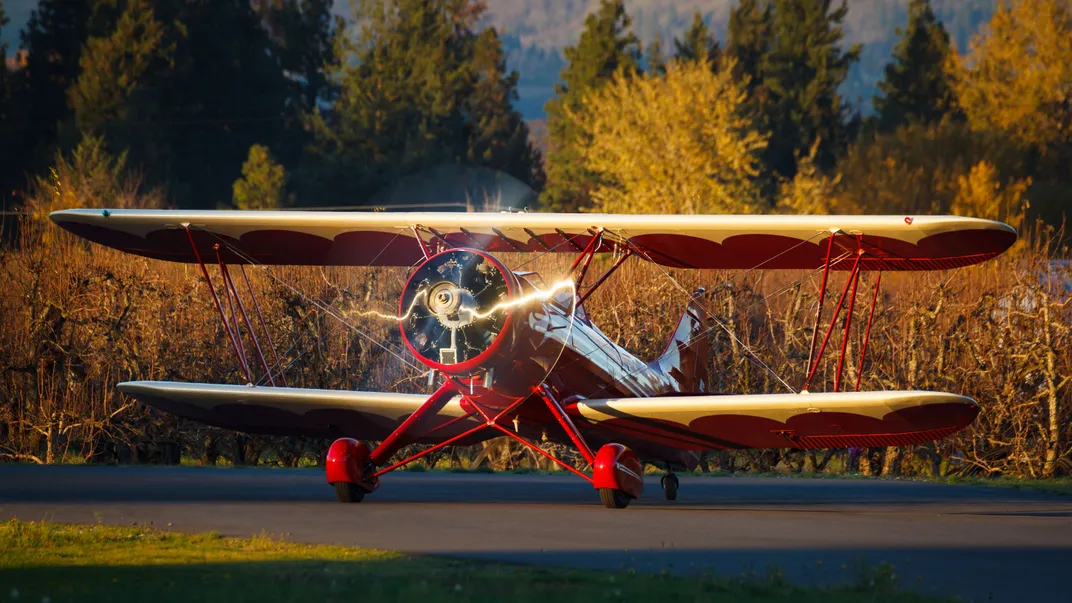
(#7) 1942 WACO UPF-7
Splendid Introduction to Flight
This aircraft has come full circle. In 1942, instructors used this UPF-7 to teach people the basics of flying. And now more than 75 years later, the biplane retains its educational mission. Immediately after leaving the Waco Aircraft Company (WACO) factory in Ohio, the UPF-7 joined the ranks of the Civilian Pilot Training Program (CPTP), flying from a facility in Georgia. Countless nervous would-be pilots took to the skies for the first time in the WACO, which helped train a small portion of the more than 435,000 men and women who participated in the program before and during World War II.
After a long, sometimes tough life that included several owners, a few accidents, and many years of storage, Jeremy Young acquired the antique WACO in 2016. His flight school, TacAero, has 32 aircraft located at many facilities throughout the United States. The company specializes in teaching pilots how to land vintage airplanes with tail wheels—a task that has been the cause of controversy and consternation for decades. Clients who plan to buy biplanes use the vintage WACO to learn the nuances of handling taildraggers.
While there are many aircraft in the TacAero fleet, the UPF-7 has come to be one of Jeremy’s favorites. “As long as you take good care of the plane’s old radial engine, it’s a great-flying aircraft,” says Young. “It is easy to handle on landing and on the ground, controls nicely in the air, and it’s a trustworthy plane that makes a flyer confident.” He adds, “And, it’s a dazzlingly beautiful aircraft too.”
See video of the 1942 Waco from LiveAirshowTV.
(Photo: Courtesy Jeremy Young)
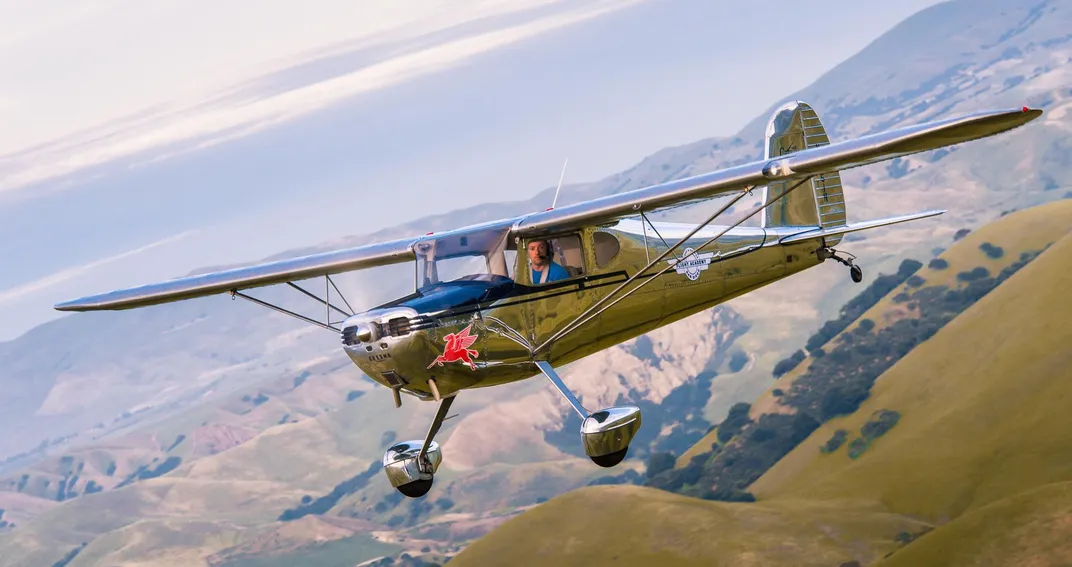
(#6) 1947 Cessna 140
Powder Puff Racer
When Josh Cawthra purchased this Cessna 140 in 2012, the idea of turning it into a showplane was the furthest thing from his mind. “It just checked all the boxes for me,” he related. “I wanted a flyer, older than 1950, a tail-dragger, and it had to be equipped with a radio. And this one was in decent shape.” He planned to fix only what he needed to and fly the airplane, a lot, just for fun. But soon, simple maintenance ballooned into much more. Cawthra is a certified aircraft mechanic and he couldn’t help himself from repairing, improving, or overhauling nearly every part of the then 65-year-old Cessna, recruiting his family and friends to assist. “I had just the right skill set to work on it,” he admitted, “and what I didn’t know how to do, I quickly learned.” All the while, he was still flying the plane 100 to 150 hours a year. In the winter when the weather turned ugly, Cawthra rebuilt the plane’s Continental C-85 engine himself.
As his nearly unintentional restoration neared completion, Cawthra began to dig into the lost history of his Cessna and was startled by what he found. A pair of former Women’s Airforce Service Pilots (WASPs) had flown his Cessna in the Jacqueline Cochran All-Woman Transcontinental Air Race, known as the “Powder Puff Derby.” On the race’s 1949 cross-country sprint from San Diego to Miami, his 140 had placed fifth.
Cawthra’s striking vintage Cessna was soon winning awards on the airshow circuit and now, because of its unique history, he plans to keep it. “If I had to sell it now, I’d have a hard time doing it,” he admits. “But I still fly the daylights out of it.”
See video of the 1947 Cessna from LiveAirshowTV.
(Photo: ©LCLPhotography)
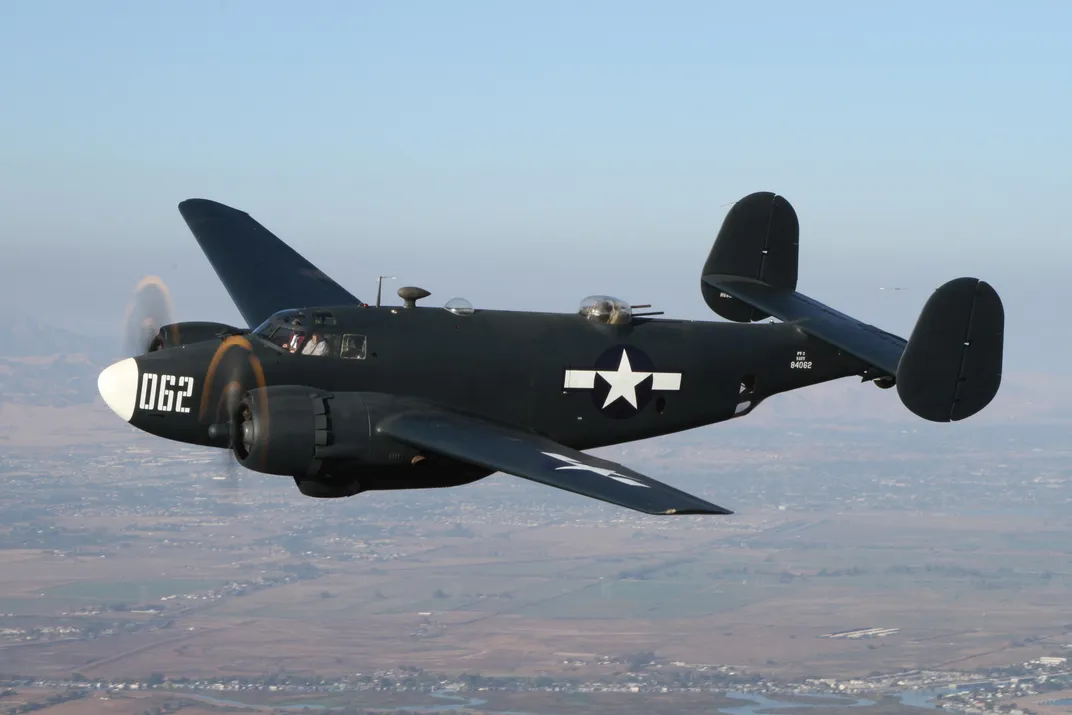
(#13) 1945 Lockheed PV-2D Harpoon
Built for the Empire Express
Almost forgotten among the legendary air actions of World War II are the long-distance bombing raids flown from Alaska’s Aleutian islands to the northern tip of the Japanese empire in the Kuriles. Known as the Empire Express, the flights over that treacherous route fell mainly to the Navy’s Lockheed patrol bombers, the PV-1 Ventura and PV-2 Harpoon. When Taigh Ramey found his rare PV-2 in 2010, abandoned in northern California, the big airplane wasn’t much more than a playhouse for ground squirrels. The new owner of the land where the airplane rested wanted the battered and bleached airplane chopped to pieces and gone. After much preparation, members of the Stockton Field Aviation Museum spent just 11 days on-site to resurrect the battered aircraft and get it back into the skies.
Only 35 PV-2Ds were built, equipped with a special nose section stuffed with eight machine guns to attack surface targets. The Navy’s order for more was quickly cancelled when World War II came to an end. When Ramey’s aircraft was sold for surplus in 1958, it had logged just seven hours of flight time. As a fire-fighting tanker, the airplane flew for another 800 hours before being left to the elements. Now, after more than three years of restoration, the venerable patrol plane looks almost the way it did when it rolled off the Lockheed factory floor in 1945.
Stockton Field Aviation Museum exhibits the Harpoon at as many airshows as possible to honor those who worked with this lesser-known aircraft type in wartime. Ramey, the museum president, uses the Harpoon to teach younger generations about World War II history. “You can learn so much more from touching, hearing, and seeing a plane like this than would ever be possible if she were sitting quietly in a museum somewhere,” he says. Ramey plans to have two pilots who flew PV-2s in World War II join him on his trip to the National Aviation Heritage Invitational in Reno this September.
See video of the 1945 PV-2D from LiveAirshowTV.
(Photo: Roger Cain)

(#9) 1950 North American T-6G Texan
It’s for Learning
During World War II, North American’s ubiquitous trainer helped develop the flying skills of hundreds of thousands of would-be Allied pilots. One of those many flying cadets was the father of this Texan’s owner, Dean Thomas. While other aviators went on to fly Mustangs and Corsairs, Thomas’ dad became an Army flight instructor. During the war, the cockpit of a Texan was his office. Young Dean Thomas flew with his father for the first time at age 13 and promptly got sick. But the experience didn’t change his mind about aviation. Today, Thomas is a retired airline pilot with nearly 30,000 hours of flight time over 44 years under his belt. The prop-driven T-6 is better than the big jumbo jets he piloted with United Airlines in a multitude of ways, he says. “You have much more freedom in the Texan,” says Thomas. “It’s incredibly maneuverable and light.” Comparing the airliners he used to fly with his far more interesting T-6, he says, “It is the difference between driving a suburban and racing a Porsche.”
The trainer was built during the war and then completely overhauled at North American’s Dallas factory in 1950. After it did service with the Air National Guard, had a brief career as an air racer, and flew several trips across the North Atlantic, Thomas acquired the veteran Texan in 2012. Today, the aircraft is used by Thomas’ Pilot Maker Foundation as a tool to spark interest in flying. At shows, people can sit in the cockpit, go for a ride, or even get a little stick time. “Everyone loves it,” Thomas remarks. “How could you not?”
See video of the 1950 T-6G from LiveAirshowTV.
(Photo: Courtesy Dean Thomas)
/https://tf-cmsv2-smithsonianmag-media.s3.amazonaws.com/filer/ff/15/ff15cb31-602c-4b05-8e0a-0a06deaee128/bela_havasreti_1952_cessna_195_credit_josh_kaiser.jpg)
(#8) 1952 Cessna 195 Businessliner
Stylin’
Speedy and spacious, airplanes like the Cessna 195 were the Learjets of the late 1940s and 1950s. The 195 had that little, indefinable something extra—style. Right down to the identifying bumps on the engine cowl (which actually have a purpose—the cowl is so tightly streamlined that the cylinder rocker arms had to be accommodated in little bump-outs), the 195 says “luxury.” When Bela Havasreti acquired this Cessna 195 nearly three and a half years ago, the first thing he and his wife did with the airplane was strip off the paint. Havasreti learned two things from the experience. First, the aircraft is stunning in bare aluminum. Second, it is one of the most pristine of its type he’s ever seen. The fact that the airplane had no evidence of repairs was no small thing. While 195s are today sought after for their great performance and stellar “vintage modern” looks, the airplane is not for beginners. “It can be a handful in cross-wind landings. I’m not wearing it like I did my previous planes,” says Havasreti. “It has my undivided attention all the time. You are not done flying it until you are sitting in a lawn chair half way through your first beer.”
Part of the reason Havasreti suspects his aircraft is so immaculate is that it was never used for corporate work. The pretty airplane was always in the hands of an owner who cherished it, and Havasreti is no exception. “I love this aircraft because it’s like riding in an old Packard,” he says. “The plane is roomy, fast, cool, has good performance, and it hauls a lot.” When asked how long he’ll keep it, Havasreti doesn’t pause for a second: “I’m going to keep this one until they nail me into a pine box.”
See video of the 1952 Cessna from LiveAirshowTV.
(Photo: Josh Kaiser)
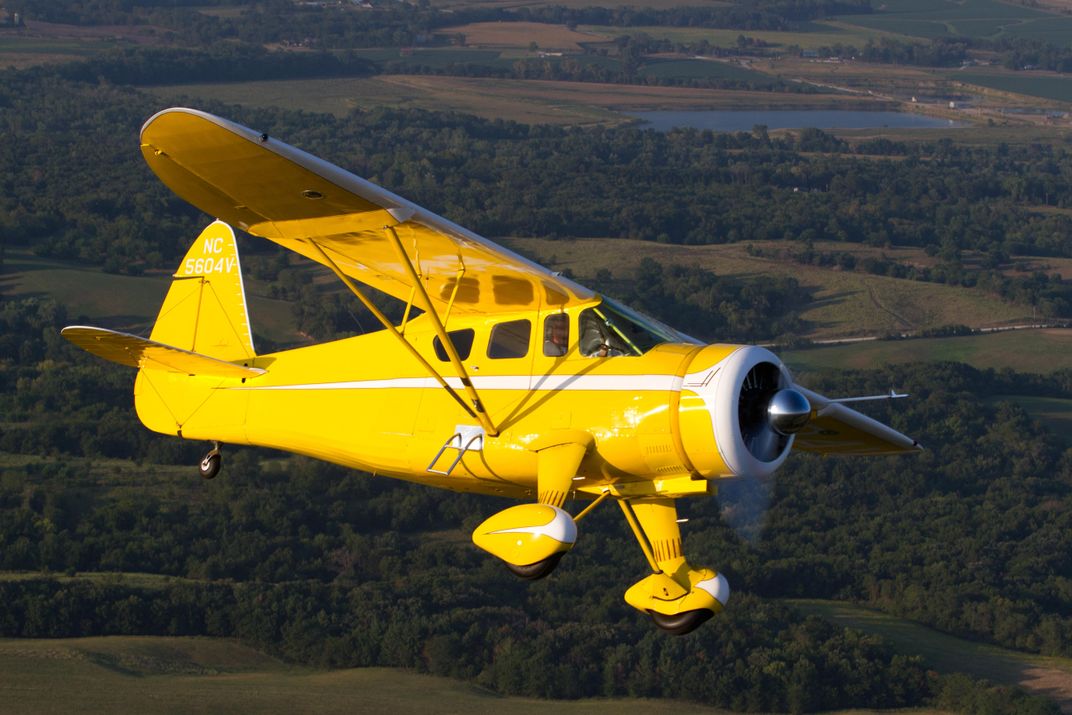
(#2) 1943 Howard DGA-15P
Damned Good Airplane
Airplane mechanic Dave Bole had a friend who got him hooked on vintage airplanes, but he never thought he’d be able to afford a Howard. “When fuel prices spiked [in the late aughts] the cost of gas-guzzling airplanes went down,” he says. He found his Howard—the beefier military variant with a Pratt & Whitney R-985 radial engine—in 2011 in Iowa City. The prior owner was an instructor, who accompanied Bole back to Seattle in the copilot seat and checked him out on the aircraft. “I had very little tailwheel time when I bought it,” Bole says. He’s averaged about 75 hours per year since then. His Howard was one of 16 based at Naval Air Station Kaneohe Bay in Hawaii during World War II, where it was used as an instrument trainer. After the war, the Navy sold it for $633 to a private airline. From there it spent time dropping rat poison on sugar cane fields. A Navy Captain bought it and had it shipped to California in 1969, where it was restored in Santa Paula. After a crash in 1985, it was substantially rebuilt, this time in Wyoming. But it’s been flying for a lot more years than it’s been idle, and it looks it, its owner readily admits. “I fly it an awful lot,” Bole says.
That’s because the Howard DGA—for "Damned Good Airplane"—is fun to fly. “It has a tremendous amount of power compared to what I’m used to: a Bellanca Viking, various Cessnas, a Mooney,” Bole says. “It’s much heavier on the controls, but very stable in the air. I keeps you on your toes, both on takeoff and landing. There’s a lot of footwork going on.”
“It’s a 4,500-pound airplane. If you can get it trimmed out, it has high wing loading so it handles turbulence very well. If you get it up to 10,000 feet, it’ll cruise at 175 or 180 miles per hour, burning 22 or 23 gallons per hour.” Those fuel stops are often lengthy because someone always wants to come talk about his Howard.
“But it’s worth it,” Bole says. “The enjoyment of flying something that old and historic; that makes a lot of noise and draws a lot of attention, it’s worth it. Of course, if you make a bad landing, it ends up on YouTube,” he laughs.
See video of the 1943 Howard from LiveAirshowTV.
(Photo: Courtesy Jonathan Apfelbaum)
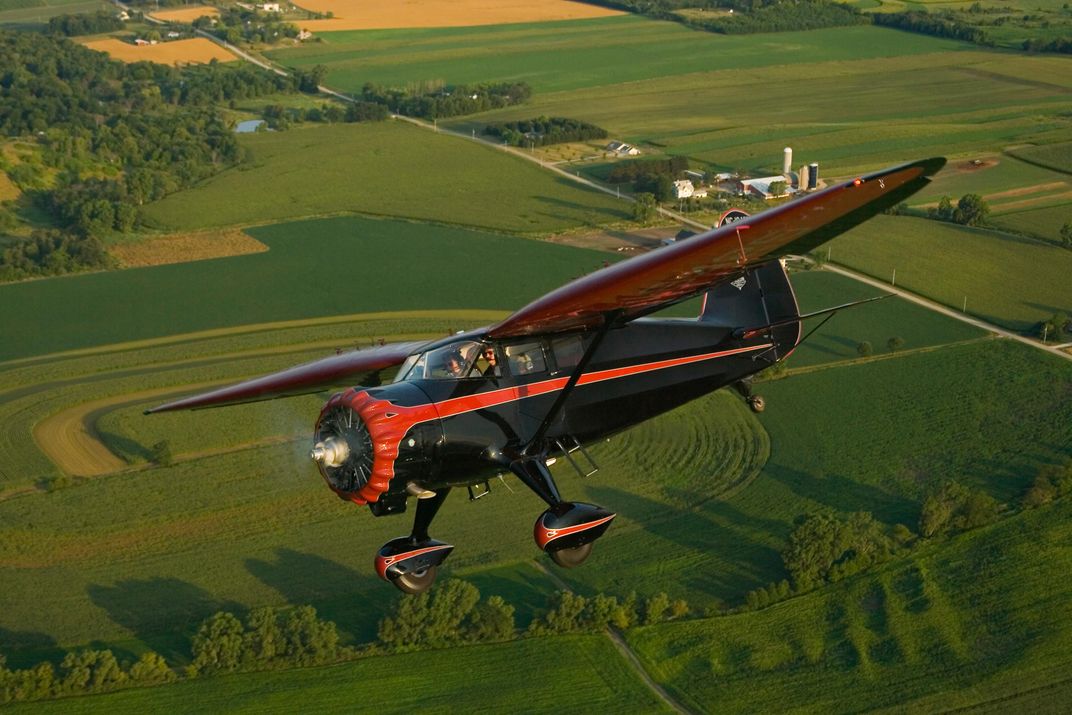
(#1) 1937 Stinson SR-9F Reliant
Elegance with Wings
RIchard A. Rezabek’s 1937 Reliant, NC 18425, is so carefully restored that it has won two previous NAHI trophies. It also won this voting contest in 2009. It’s a rare specimen, powered by the same Pratt & Whitney Wasp Jr. engine that was installed in 1951, and with its original sheet metal, cowls, wheel pants, fuselage, and landing gear struts. But the path that led Rezabek to buy this classic monoplane in 2005 went through one of the newest and most advanced fighters in the world. Rezabek was Lockheed Martin’s chief engineer on its X-35 project from 1992 through 2001. Once Lockheed Martin was awarded the contract for what would be designated the F-35 Lightning II, he chose to spend more time indulging his passions. In 2002, he got his license to fly and bought a Stinson Voyager from a retired Navy captain.
His Reliant originally belonged to Katherine May Edwards, an owner of several Pennsylvania newspapers who used it to fly around the state to her various publications. In 1941, she was forced by the U.S. government to sell it to Wright’s Motion Pictures of Jamestown, New York, to aid the war effort, though she would buy it back again after the end of World War II, and after it had been owned for several years by Republic Aircraft, who used the Reliant to check out new test pilots.
Most of what Rezabek knows of his airplane’s early history comes courtesy of Edwards’ nephew, Sidney Dickson, who looked him up after he learned Rezabek had acquired his aunt’s old airplane and was eager to share its history.
Rezabek says it remains a showstopper at fly-ins. “I always let kids sit in the cockpit to try to get them excited about aviation,” he says. But adults who are already experienced flyers are eager to admire his Reliant too.
See video of the 1937 Stinson from LiveAirshowTV.
(Photo: Courtesy James Lawrence)
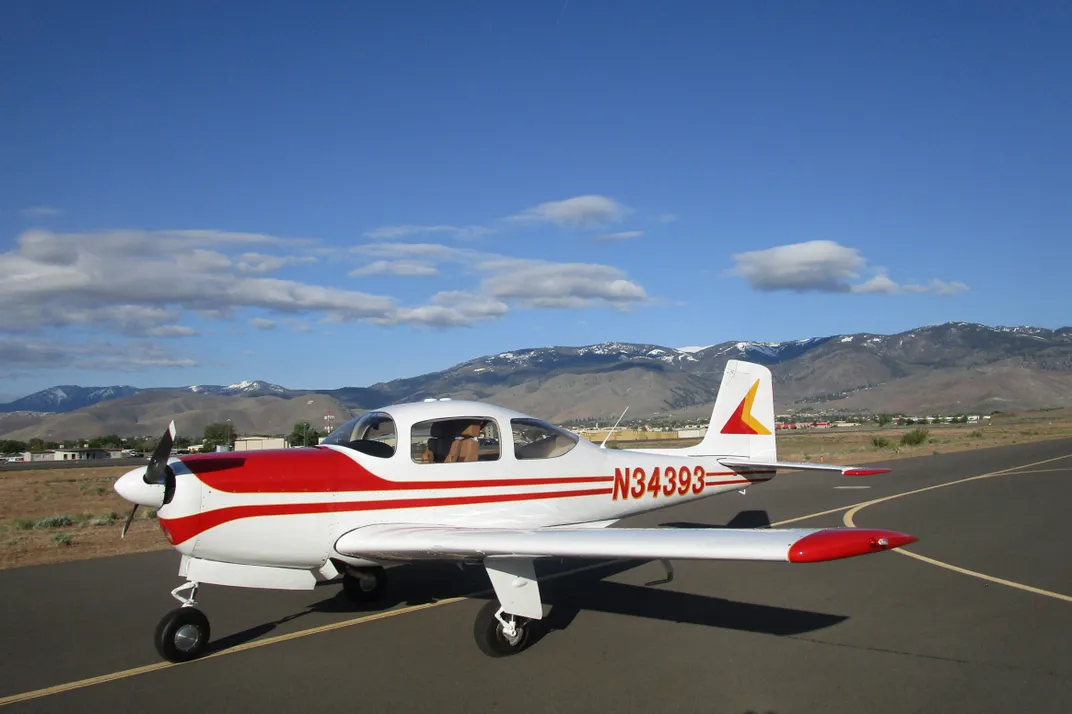
(#5) 1962 Meyers 200B
Movie Star Speedster
Edna Gardner Whyte is not as famous a pioneering aviator as Amelia Earhart or Jackie Cochran, Bruce Mayes admits. One way he knows this is because he’d never heard of Whyte—four-time winner of the Women’s International Air Race, president of the Ninety-Nines from 1955 to 57, first woman to be admitted to the exclusive military-pilot Order of Daedalians, and a flight instructor whose career spanned 60 years—until he became the fourth owner of the 1962 Meyers 200B that Whyte had borrowed to fly at the Reno Air Races in 1968. She’d flown plenty of airplanes over the prior three decades, but she was just as seduced by the single-engine light sportster’s fleetness, ease of handling, and fetching lines as Mayes was. (The type's movie-star good looks earned it an appearance in the 1967 James Bond film You Only Live Twice.)“Meyers only designed three airplanes,” Mayes says. “The first was a military biplane trainer. There was not a single fatality as a result of the airplane. Which in military training is almost unheard of.” In his third design, the 200,Meyers retained reliability with a sturdy chrome-moly steel skeleton, but the airplane was built for speed. The 200B cruises at 200 knots, but it’s the rate of acceleration, rather than the cruising speed, that struck Mayes when he first began flying it. “Once you put it into a slight descent, it really speeds up fast,” he says.
“The original interiors of these airplanes, they kind of look like 50s diners,” Mayes says. “He wasn’t as concerned about the accoutrements as about performance.”
Mayes’ airplane is one of only 17 B-variants built and is the second he’s owned. He crash-landed his first in a boulder-riddled field on his way to Oshkosh in 2016 and credits the sturdiness of the airplane with protecting him and his wife from more serious injuries.
See video of the 1962 Meyers from LiveAirshowTV.
(Photo: Courtesy Bruce Mayes)